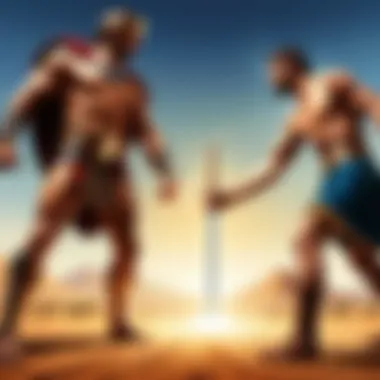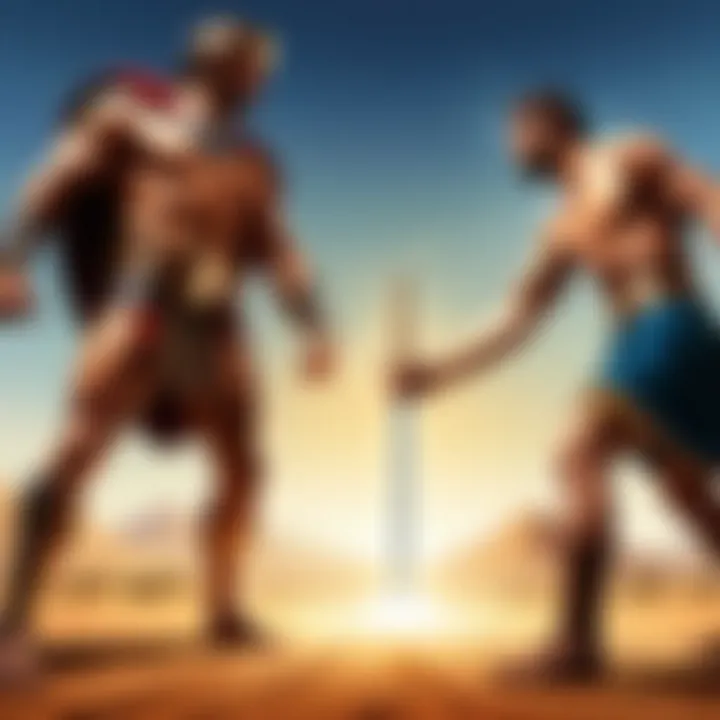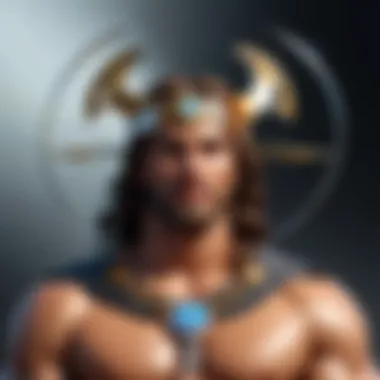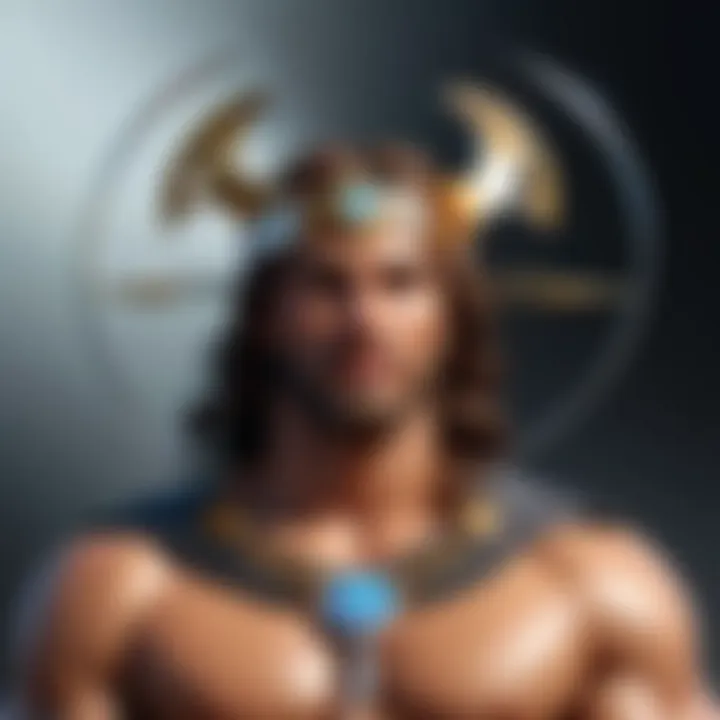The Power and Faith Dynamics in David and Goliath


Intro
The story of David and Goliath holds a special place within not only religious texts, but also in the moral fabric of our society. It transcends the simplicity of a tale about a shepherd boy and a giant warrior, expanding into a narrative that examines the complexities of power and faith. This account, steeped in historical context, reveals profound insights into human nature, especially when one considers the motivations behind each character's actions.
In essence, the narrative serves as a mirror reflecting the struggles individuals face when confronting overwhelming odds. The juxtaposition of David's faith against Goliath's brute strength encourages a discourse that extends beyond mere storytelling and taps into deeper philosophical questions about courage, belief, and the essence of what it means to be human.
This article aims to dissect these layers and uncover the dynamics present in this ancient tale, revealing how relevant it still is today. Emphasizing its implications helps us understand the continued significance of this narrative in contemporary discussions about power and the human condition.
Historical Context of the David and Goliath Narrative
Understanding the historical context of the David and Goliath narrative is crucial for appreciating its depth and implications. This tale of an unexpected triumph encapsulates much more than just a battle; it reflects the tumultuous dynamics of power and the significance of faith in times of strife. Set against a backdrop of deeply rooted animosities between the Philistines and Israelites, the story speaks to the collective psyche of a community grappling with identity, survival, and divine intervention.
The Setting of the Philistine and Israelite Conflict
This ancient conflict birthed a narrative that resonates even today. The Philistines, known for their formidable military prowess and advanced technology of warfare, stood as a paragon of oppression to the Israelites. They occupied much of the coastal territory and posed a significant threat to the agrarian communities of Israel. In contrast, the Israelites—primarily shepherds and farmers—struggled for autonomy and self-definition.
The starkness of this dichotomy is what makes the David-Goliath encounter so compelling. With Goliath, a giant warrior representing the might of the Philistine army, and David, a humble shepherd boy, facing each other, the tale captures the tension inherent in conflict: the large, intimidating adversary against the optimistic underdog. The protagonist's victory symbolizes hope and divine favor, stirring the hearts of those in tune with faith and righteousness.
Cultural Significance of Giant Myths
The motif of giants is prevalent in various cultures, often embodying challenges that seem insurmountable. In the world of the David and Goliath story, Goliath can be seen as the epitome of all that is daunting—a physical manifestation of oppression, fear, and the unknown. These giants serve not only as enemies in the narrative but as archetypes reflecting the struggles society faces.
From ancient Greek mythology with figures like Polyphemus to the biblical Nephilim, such myths highlight a universal theme: confronting overpowering adversaries requires not merely strength, but also courage, strategy, and faith.
"The giants of fear and adversity loom large over us, but like David, we must wield our own slingshots of belief to strike true."
Through examining the historical context and cultural significance of giant myths, we peel back layers of meaning in the narrative. This analysis invites introspection on what Goliath-like figures exist in our lives today and challenges us to reconsider our own capacities for faith and courage in the face of daunting challenges.
Character Analysis: David and Goliath
The character analysis of David and Goliath provides a multifaceted view into the very heart of this timeless narrative. The tale is not just a story of a battle; it personifies and illustrates the dynamics between contrasting figures that resonate with us even today. As we parse through the characteristics and symbolism behind these two individuals, it helps illuminate broader themes surrounding power, faith, and the human experience itself.
David: The Underdog
David emerges as an emblem of the underdog, embodying the spirit of resilience and ingenuity. A shepherd boy, he carries with him a sense of simplicity yet profound courage when he faces adversities that appear insurmountable. Leveraging his trust in God, his resourcefulness plays a crucial role in shaping the narrative. When distinguishing David from formidable warriors, it’s not merely his size or equipment but rather his unshakeable belief and adaptability that sets him apart.
In contemporary contexts, David’s representation resonates with anyone who might feel an imbalance of power in their own life. This archetype serves as a reminder that greatness does not stem solely from size or status. The significance here lies not only in his victory over Goliath but also in how he inspires others to stand tall against their obstacles.
Goliath: The Symbol of Oppression
On the opposite end stands Goliath, characterized not just by his physical presence but as a symbol of oppression. He represents everything oppressive and menacing�—intimidation, unchecked power, and domination. To view Goliath merely as a giant would be a misstep; he encapsulates the fears and struggles that people face when confronted by overwhelming forces.
Goliath's demand for a one-on-one duel signifies not only physical confrontations but, more profoundly, the struggle against systems and ideologies that seek to stifle or suppress smaller entities. In today's world, Goliath embodies corporate giants, authoritative regimes, or any societal structure suppressing individual agency. Understanding Goliath’s characterization encourages us to contemplate the nature of power dynamics and the inherent struggles faced by those at the bottom of the hierarchy.
Heroes and Antiheroes in the Narrative
This narrative also introduces us to the concept of heroes and antiheroes, enriching the analysis further. David is sculpted into a classic hero figure, his qualities extolled, while Goliath can be seen through a dual lens—an antihero. In modern narratives, antiheroes often capture the audience's attention due to their complexity. This acknowledgment opens a path for deeper reflection on morality, ethics, and decision-making.
In the context of this biblical story, both characters hold up mirrors to society. They compel us to question our own beliefs about heroism and morality. The portrayal of David and Goliath prompts us to scrutinize not simply the dichotomy of good versus evil but the nuances that challenge those boundaries.
"In every battle we face, we often find ourselves slipping into one role or the other, a reminder that both heroes and antiheroes exist within us all."
By dissecting these characters, we unravel layers beneath the surface, exposing attitudes, aspirations, and the human conditions that continue to shape our world today. This analysis not only cultivates a better understanding of the David and Goliath tale but encourages a critical examination of our own narratives, relationships, and societal dynamics.
The Mechanics of the Duel
Examining the mechanics of the duel between David and Goliath not only sheds light on their individual capacities but also provides a lens through which we can analyze the conflict's representation of power dynamics, faith, and strategy. This narrative, set against a backdrop of overwhelming opposition, maps out how even a seemingly insurmountable challenge can be deconstructed by insight, tactics, and sheer determination. Here, we'll delve into the tactics and strategies employed during this pivotal encounter as well as explore the profound symbolism behind David's slingshot.


Tactics and Strategies Employed
David’s victory did not hinge solely on luck or divine intervention but on keen tactics and a strategic mindset. Surveying a battle between a giant and an underdog, it's clear that agility and creativity played significant roles in shaping the outcome.
- Terrain Awareness: David understood the landscape well. The choice to engage Goliath in an open field minimized Goliath’s advantage of close combat, where brute strength would have reigned supreme.
- Psychological Play: The psychological aspect cannot be overlooked. David's decision to challenge Goliath, openly and confidently, positioned him as a figure of defiance. This couldn't have only stirred doubt in Goliath but also set a powerful narrative for those witnessing the encounter.
- Utilization of Tools: Instead of armor and traditional weapons, David opted for a slingshot and stones. This not only highlighted his resourcefulness but also emphasized a fundamental truth: sometimes, the apparatus of one’s victory can be those very items deemed inferior. He took something considered simple, perhaps even mundane, and harnessed it into his weapon of choice.
The tactics were multifaceted, incorporating not merely physical actions but also psychological warfare and environmental factors. The duel, thus, stands as a testament to the old adage that it's not the size of the dog in the fight but the size of the fight in the dog.
Symbolism of the Slingshot
When examining the story's narrative arc, the slingshot emerges as a powerful symbol, embodying the restless spirit of innovation and the spirit of the underdog. Here are some pivotal points to consider about its significance:
- Tool of Precision: David’s choice of a slingshot indicates precision over power. In a world often driven by physical dominance, the slingshot represents the subtle art of effectiveness. It encapsulates the idea that intelligence and skill can often eclipse sheer muscle.
- Faith in Unorthodoxy: The slingshot’s unusual nature mirrors David's own status as an outsider among warriors. It illustrates how faith in unconventional means can yield extraordinary results. David trusted his aim, demonstrating a belief not just in his abilities but also in a higher force guiding him.
- Spirit of Rebellion: The remarkable image of a young shepherd facing a towering giant with such a humble tool weaves a narrative of rebellion against oppression. The slingshot signifies a struggle against the status quo, a reminder that the marginalized can rise against the powerful with determination and ingenuity.
As a whole, the mechanics of the duel present a comprehensive exploration of how seemingly simple elements combined can shift the balance of power. By honing in on tactics and the testament of faith represented by the slingshot, we unearth layers of meaning that speak to both historical context and modern implications of the David versus Goliath narrative.
"It’s all about strategy, not size. The clever will always outmaneuver the strong."
While many might see the duel as just a tale of triumph, it intricately weaves the essence of resilience, strategy, and the audacity to confront giants, extending its lessons far beyond the battlefield.
Themes of Faith and Providence
The story of David and Goliath resonates deeply beyond its immediate plotline, tapping into undercurrents of faith and providence that echo through the ages. At its core, this narrative reveals how personal beliefs and the perception of divine intervention shape human experiences and outcomes. In a world where uncertainty looms large, the themes of faith and providence become beacons for individuals navigating adversity.
Divine Intervention in Human Affairs
In the David and Goliath saga, the notion of divine intervention is apparent. David, a mere shepherd, faces a towering giant, Goliath, whose very presence strikes fear into the hearts of seasoned warriors. But it’s not just David’s skill with a sling that turns the tide; his unwavering faith in God serves as the bedrock of his courage.
In historical and theological contexts, divine intervention often signifies a suspension of natural laws, a phenomenon where the human experience intertwines with the supernatural. David's victory can be seen as a manifestation of this idea, where the odds are defied because of faith. The phrase "the battle is the Lord’s" embodies the belief that higher powers guide human destinies, allowing individuals to confront seemingly insurmountable challenges. Within this framework, David isn't just a soldier; he emerges as a vessel of divine will, illustrating how faith can bridge the gap between the ordinary and the extraordinary.
The Role of Faith in Overcoming Adversity
The power of faith goes beyond mere belief; it acts as a framework for resilience. David's encounter with Goliath illustrates how faith can enable individuals to harness their inner strength. In dire situations, a strong belief can embolden one to act decisively. David’s faith fueled his determination, turning trepidation into a purposeful drive. This transformation showcases how belief can alter perceptions and provide clarity amid chaos.
In contemporary society, the lessons from David’s story resonate with those facing their own giants—be it personal struggles, societal challenges, or professional hurdles. Embracing faith can lead to profound changes in mindset. An individual might not wield a slingshot, but the metaphorical stones of belief can be equally powerful. The emphasis on faith, be it spiritual or secular, teaches that intrinsic strength lies not just in physical prowess but in the confidence derived from belief.
"Faith sees the invisible, believes the unbelievable, and receives the impossible."
Moreover, the implications stretch into various realms, including mental health and emotional resilience. When confronted with hardship, holding onto faith can cushion the fall. It acts as a reminder that challenges might be steep, but encouragement can emerge from the most unlikely sources. It’s this synergy between belief and action that crafts a narrative of triumph, echoing through generations.
The Legacy of the David and Goliath Story
The narrative of David and Goliath has transcended beyond its biblical roots to become a powerful metaphor in various domains of life. This story symbolizes the struggle between the powerful and the weak, serving as an archetype demonstrating how faith and cleverness can prevail against overwhelming odds. It provides a rich terrain for exploring themes of courage, resilience, and justice.
Not only does this tale illustrate how underdogs can conquer seemingly insurmountable challenges, but it also raises critical questions regarding the dynamics of power. The legacy of David and Goliath encourages individuals to reflect upon their own battles, urging them to confront adversity with tenacity and hope.
Cultural References and Impact
Throughout history, the David and Goliath story has permeated various cultural narratives, serving as a touchstone for discussion in literature, cinema, and social movements.
- Literature: From classic novels to modern bestsellers, many authors have borrowed from the archetype of the underdog, crafting characters and plots that echo the foundational elements of this tale. Examples include George Orwell’s Animal Farm, where the pigs represent a powerful oppressor, or even Harry Potter, where Harry, much like David, stands against a formidable foe.
- Cinema: Movies frequently draw on the blueprint of the underdog struggle. Films such as Rocky and The Pursuit of Happyness not only highlight the personal battles of their protagonists but also channel the emotive core of the David and Goliath narrative, inspiring audiences worldwide.
"The true measure of success is not whether you are at the top of the ladder, but whether you can climb it time and again, no matter the obstacles in your way."
- Societal Movements: The tale has inspired countless social movements, where small groups have challenged larger entities. Movements advocating for social justice, environmental causes, and civil rights often invoke the spirit of David’s triumph to foster unity and hope against powerful adversaries.
In essence, the cultural impact of this story is vast, fostering a sense of belonging and resolve among individuals. It gives voice to those who feel powerless, providing comfort that even the most daunting challenges can be faced with determination.


Modern Adaptations and Interpretations
As society evolves, so do the interpretations of the David and Goliath narrative. Modern adaptations increasingly reflect today's complexities, resonating with contemporary audiences.
- Media: Today's digital landscape is rife with reinterpretations of the David and Goliath theme. Viral stories on social media platforms showcase everyday Davids—individuals or small businesses taking on larger corporations. These narratives often gain traction on platforms like Reddit and Facebook, illustrating the ongoing relevance of the underdog story.
- Business: In the world of start-ups and entrepreneurship, the David and Goliath narrative is invoked regularly. Entrepreneurs who establish successful businesses despite facing giants like Amazon or Google often draw on this legacy to inspire others. Their stories reinforce the idea that with unique ideas, perseverance, and often a bit of creativity, it’s possible to carve out a niche against larger competitors.
- Community Initiatives: Grassroots organizations often embody the spirit of David and Goliath. They tackle issues like poverty, education inequities, and climate change, encouraging civic engagement and a collective rise against systemic challenges.
As these adaptations emerge, the essence of the narrative remains intact—a rallying cry for anyone facing overwhelming odds, proving that size doesn’t always dictate the outcome of a confrontation.
Psychological Insights: The Human Condition
Exploring the psychological dimensions of the David and Goliath narrative reveals profound truths about the human experience. The themes of fear, courage, and the complex ramifications of victory and defeat resonate throughout the ages. This section sheds light on these dynamics, examining how individual mindsets can shape the outcomes of confrontations and the subsequent journeys of those involved.
Fear and Courage in Confrontation
Fear is a primal instinct, coursing through the veins of every individual when faced with daunting challenges. In the face of overwhelming odds, it is this fear that can either paralyze or galvanize one’s response. David, the youthful shepherd, stood before Goliath — a towering behemoth representing not just physical might, but also the collective anxiety of an entire nation. The fear coursing through the Israelite soldiers was palpable, creating an atmosphere laden with despair.
However, David's courage wasn’t born from a lack of fear; rather, it sprang from his ability to channel that fear into action. His faith in God and his own skills transformed his trepidation into resolve.
"Courage is not the absence of fear, but the triumph over it."
This perspective is essential in queries around psychological resilience. Understanding how fear can be harnessed into courage helps illuminate why some individuals triumph over adversity while others buckle under their burdens. The duel between David and Goliath is not just a clash of weapons; it's an inner battle that many face. Recognizing this pattern in human behavior is invaluable, especially for those tackling their own giants in contemporary life.
The Implications of Victory and Defeat
Victories often come with a mixed bag of emotions and consequences, and defeats can sometimes sow the seeds of resilience. In the aftermath of David's stunning victory over Goliath, he did not just claim personal glory. Rather, he became a symbol of hope, rekindling the spirit of a beleaguered nation. This narrative illustrates a crucial psychological insight: victories can elevate one's status and instill a keen sense of purpose, but they also carry the weight of expectations and responsibility.
On the flip side, Goliath's defeat signifies the heavy toll of losing not just a battle, but also one's perceived might and invulnerability. The psychological impact of such a defeat can be profound, leading to feelings of shame or inadequacy. Understanding the ramifications of both victory and defeat can provide valuable lessons about resilience and psychological health.
In summary, the psychological dynamics in the David and Goliath story exemplify key aspects of the human condition. Fear, courage, and the implications of outcomes shape who we are and how we navigate our lives. Recognizing these elements allows for a deeper appreciation of personal growth, resilience, and the complexities surrounding our struggles.
This discourse contributes to the broader understanding of the interplay between power and faith, urging us to reflect on the intricacies of human emotions in high-stakes situations.
David and Goliath in Contemporary Society
The story of David and Goliath, while rooted in ancient history, maintains a profound relevance in today’s world. This tale not only reflects power dynamics and faith but also resonates deeply in various facets of modern life, particularly in conflicts and personal development. We often find ourselves in situations that mirror the struggles within this biblical narrative, where the underdog must confront overwhelming odds. Understanding how these themes translate into contemporary society can yield valuable insights into our own challenges and aspirations.
Lessons for Modern-Day Conflicts
In many conflicts today, the narrative of David and Goliath serves as a blueprint. It reminds us that size and strength don’t always define the victor. For instance, think about grassroots movements tackling systemic issues. These groups often operate with limited resources but wield significant influence by rallying community support. The Arab Spring, for example, showcased how ordinary citizens could stand up to oppressive regimes.
- Unity and Strategy: Much like David, these groups utilize not just their passion but also strategic thinking and unity. They can mobilize collective action, crafting a narrative that challenges the status quo.
- Symbolism of the Underdog: The underdog scenario evokes empathy and motivation, helping garner international attention. Just as David’s battle resonated beyond the battlefield, modern struggles often draw global support.
As we navigate through issues like inequality and injustice, recognizing these dynamics equips us with the wisdom needed to face and transform circumstances, even those that seem insurmountable.
Influence on Business and Personal Development
The David and Goliath metaphor extends well beyond social movements into the realms of business and personal growth. Many entrepreneurs and individuals seek inspiration from this tale, redefining their approach to success and challenges.
For instance, when startups attempt to break into markets dominated by industry giants, they often adopt a David-like mentality.
- Innovation Over Might: Smaller companies leverage innovation, agility, and customer connection, pushing back against larger firms with their agility and creativity. Success stories like Airbnb or Tesla echo this sentiment – they challenged established norms and emerged victorious.
- Mindset of Resilience: On a personal level, this narrative teaches the importance of resilience. Whether confronted with career hurdles or life changes, adopting a David mindset can inspire perseverance and creativity in problem-solving.
"The struggle of David against Goliath is not just an ancient allegory; it is a framework for navigating the complexities of our modern landscape."
In summary, the story of David and Goliath in contemporary society illustrates that confrontation and challenge can lead to profound growth, both in societal conflicts and personal endeavors. By understanding and applying these lessons, we can cultivate a mindset that embraces challenges, encouraging us to fight valiantly against the giants in our lives.
As we reflect on these themes, it becomes clear that the principles represented by David and Goliath are not merely historical; they are crucial to our understanding of power, faith, and the human spirit in today’s context.


The Rhetoric of the Underdog
The narrative of David and Goliath has transcended its biblical origins, transforming into a powerful symbol of hope and resilience. The rhetoric surrounding the underdog resonates deeply within society, offering a lens through which the balance of power, faith, and personal struggle can be examined. Underdog stories mirror life in its essence, illustrating how those who are seemingly disadvantaged can rise against insurmountable odds. This examination plays a crucial role in understanding not only the biblical tale itself but also its broader implications in contemporary discourse.
The Power of Narrative in Society
The underdog narrative holds immense power in society. It captures the attention of the masses and serves as a rallying cry for those feeling powerless. Stories of individuals or groups overcoming extreme challenges through grit and determination foster a sense of solidarity and inspiration among listeners. This appeal lies in its ability to evoke empathy and hope, creating a connection between the audience and the story's protagonist.
- Empathy and Connection: Audiences often find themselves rooting for the underdog; this connection stems from shared human experiences of struggle. It invites listeners into the character's emotional journey, making the outcome feel personal.
- Inversion of Expectations: One of the most compelling aspects of the underdog story is its potential to subvert expectations. The seemingly weaker party often triumphs in surprising and unexpected ways, serving as a reminder that strength isn't just about size but also about determination and strategy.
- Cultural Reflection: The pervasive nature of the underdog narrative across cultures is a testament to its significance. From literature to film, it reflects humanity's admiration for resilience, echoing across generations and mediums.
Manipulation of the Underdog Narrative
While the underdog narrative can empower and inspire, it can also be strategically manipulated. Those in positions of power might adopt underdog status to garner public sympathy or divert scrutiny from their actions. This manipulation can shape public perception, leading to skewed interpretations of power dynamics.
- Political Rhetoric: Politicians often position themselves as underdogs to connect with voters. By emphasizing adversity, they create a narrative of struggle against larger entities, which can rally support, even if their actual status remains privileged.
- Branding and Marketing: Companies leverage the underdog framework to build brand identity. A small business, for instance, may highlight its struggle against industry giants to create a narrative that resonates with consumers seeking authenticity and relatability.
- Media Sensationalism: The media plays a crucial role in shaping narratives. Framing a story with underdog themes can enhance engagement, but it can also oversimplify complex issues, reducing individuals or communities to mere archetypes.
This complex interplay of the underdog narrative challenges us to think critically about the stories we consume and how they influence our perceptions of power and agency.
Ethical Considerations in the Narrative
The tale of David and Goliath, while primarily viewed as a story of triumph against overwhelming odds, also presents a complex web of ethical considerations. These moral inquiries extend beyond the narrative itself, shaping the way we understand power, responsibility, and justice in both ancient historical contexts and contemporary society. By examining these ethical dimensions, we can glean valuable insights into the motivations of the characters, the broader societal implications, and the lessons we can apply in our own lives today.
Understanding the ethical framework within this narrative encourages readers to reflect on their own beliefs and values. The characters’ choices and actions serve as touchstones for conversation, illuminating the often murky waters of right and wrong. It's not just about the heroics of David or the brutish nature of Goliath but also about the societal structures that foster such conflicts. This shifts focus to how values such as honesty, justice, and humility resonate through both personal and collective actions.
"The most morally courageous act is often the least popular."
Moral Lessons Derived from the Conflict
The conflict between David and Goliath is laden with profound moral lessons that resonate throughout history. One pivotal lesson centers on the concept of courage in the face of adversity. David, though young and inexperienced, steps forward while his countrymen cower in fear. This choice speaks volumes about the weight of personal integrity and courage. It teaches us that sometimes, standing up for what is right, despite the odds stacked against us, can lead to remarkable transformations.
Moreover, the narrative speaks to the notion that true strength does not always come from physical might. David’s victory using only a slingshot reveals that intelligence and resourcefulness can triumph over brute force. This lesson is especially pertinent in today's tech-driven world where innovation often outpaces traditional means of power.
- Courage over Cowardice: The battle is a study in the difference between the fearless and the fearful.
- Wisdom over Brawn: Victory achieved through ingenuity often outweighs victories achieved by sheer might.
The Dilemmas of Power and Responsibility
The encounter between David and Goliath also lays bare the dilemmas surrounding power and responsibility. Goliath represents not just physical strength but the moral ambiguity associated with oppression. His intimidating presence prompts questions about the responsibilities that come with power. Do those in power bear a higher ethical burden? Or does the mere act of wielding power corrupt the morally sound?
Reflecting on David's ascent from shepherd to king emphasizes the profound responsibility that new-found power entails. As he moves to defeat Goliath and subsequently leads a nation, David grapples with the ethics of leadership, governance, and justice. He must navigate the turbulent waters of power dynamics, shaping a kingdom in the wake of his triumph.
In our contemporary world, these themes hold an enduring significance. They push us to examine how we exercise power in our organizations, communities, and personal relationships.
- Power's Nature: Can power be purely righteous, or does it always bring along a shadow of responsibility?
- Leadership Ethics: What moral frameworks should guide our actions once we step into positions of influence?
Culminations and Final Reflections
As we explore the deep and multifaceted layers of the David and Goliath story, it becomes clear that this ancient narrative transcends its simple plotline. It reflects a collision of power and belief, one that resonates with audiences across various generations. The clash between David and Goliath acts as a powerful metaphor for the struggles faced by individuals and social groups when confronting overwhelming odds.
Summarizing Key Insights
Among the major insights gathered from this exploration includes the significant role that faith plays in navigating adversity. David, a mere shepherd boy, exemplifies how belief in a higher purpose can empower an individual. This story highlights that even the most seemingly insignificant figures can wield considerable influence over fate when underpinned by unwavering determination and faith. Key takeaways from our journey through the narrative include:
- The Underdog Wins: The classic underdog narrative serves not just to entertain but inspires hope in the face of hardship.
- Dynamics of Power: Understanding how power shifts during confrontation is crucial, as it reflects broader social structures.
- Cultural Resonance: This story has permeated through history, influencing modern tales and common sayings that relate to overcoming the odds.
With such insights in hand, the concluding reflections invite readers to recognize their resilience and potential in the face of daunting challenges.
The Enduring Relevance of David and Goliath
Even centuries later, the relevance of the David and Goliath narrative rings true in our contemporary context. As society witnesses various forms of oppression and challenge, this story continues to remind us that faith and strategy, even when fueled by limited resources, can topple larger forces.
Issues such as socio-economic inequality, political injustices, and personal challenges can be observed through the lens of this narrative. The ongoing relevance can be summarized as follows:
- Inspiration for Movements: Many modern social and political movements look to this archetype as a rallying cry, encouraging individuals to rise up despite the odds.
- Business Strategy: Entrepreneurs often adopt the David vs. Goliath mentality to push against monopolistic enterprises, emphasizing innovation over brute strength.
- Personal Resilience: It serves as a reminder for individuals to harness their inner strength when faced with challenges, reinforcing the notion that size doesn’t dictate capability.
As the narrative continues to echo through the ages, it urges us to reflect on our role within the broader spectrum of power dynamics, igniting the spirit that dwells within every underdog.







